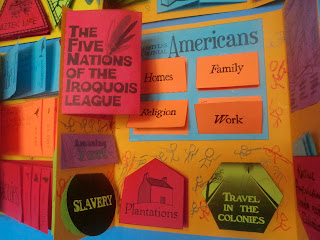Our favorite Tapestry of Grace craft activities are the lapbooks. They are so much fun! Because I have a toddler, some of the other craft activities are too time intensive for our family now, but the lapbooks are fun, take just a little time a week, and we end up with a wonderful project that my lower grammar son can take to his weekly co-op group and display in our home.
My lower grammar son and I spend about three hours a week using TOG. This is usually divided between two days a week, an hour and a half each day. During this time, we read history or literature books and complete lapbook pages. I try to wait until my toddler is napping before we have our Tapestry time, that way we're not interrupted.
This is how we complete the lapbooks in our homeschool. When we start a new unit, I take a look at all of the lapbook activities we'll be completing for that unit. Each lapbook kit comes with an assignment sheet, an instructions sheet, and an at a glance sheet that shows you what the finished project will look like. Because my son is only six years old and I have a two year old that requires a lot of attention, I let the lapbook activities drive what we will study for that unit. This works well because TOG's history lessons for the grammar - dialectic stages are integrated into each lapbook kit.
For example, last week, we read a story about Florence Nightingale and completed a lapbook activity that summarized her life. Because my son is still learning to spell and write, he narrated a sentence for me to write into his lapbook. Sometimes, I write his sentence on a whiteboard and allow him to write it into the lapbook, depending on how much space he has to write in. He may also choose to draw pictures into his lapbook pages and will narrate a caption or label for me to include on the page. Once the lapbook page is done, we glue it into the book and move on to another one. I check off on the activity sheet as we complete them and make sure we have the books or resources we need for the next week. Then we're done! We usually spend 3 hours or less a week doing our Tapestry work and divide that into 2 days over the course of the week.
We love lapbooks because of the variety of information that we can study and record onto the pages. My son enjoys the challenge of recalling the facts that he has learned. Most of all, he loves sharing his lapbook with his family and friends. Whenever his grandparents visit, he sits them down and explains every lapbook page and flap to them. They are pleased to see how much he is learning.
Another added plus is that cutting, writing and pasting every week allow him to work on his fine motor skills in a way that is fun and meaningful.
I think I've learned a lot from the lapbook activities as well. They help me to keep moving through the curriculum and to do things that I wouldn't normally consider. For example, each lapbook has a vocabulary activity. I often neglect to introduce new vocabulary to my six year old - I just don't think about it. But by doing the activity, not only do I introduce it, but since the page is glued into the book, I can refer back to the words as we come to them in our studies. Fantastic!
The lapbook also helps me to teach my son research skills. For example, when we studied Australia, we did research on the flora and fauna of the region, as well as the Coral Reef. We used multiple books and a couple of websites to complete that activity. Well, now my son is aware that research takes time and requires multiple sources. This is something I would have thought he was too young to learn.
Through using TOG resources like the lapbooks, I'm learning that there is so much that my children can learn, regardless of their ages. Research skills, rich vocabulary, poetry, map skills, timelines, etc. Not to mention, there are things that I never knew about that we learn about together. That usually becomes one of our Amazing Facts. My son likes it when I say, "Wow, I didn't know that."
Best of all, after the project is done, my son has a tangible product that he can keep for years as proof of what he's learned. The next time we cycle back to that year plan, he can create another lapbook and compare it to what he did before and see for himself how much he's grown as a learner. And if he decides that he doesn't want to do lapbooks anymore, that's okay, too. There are many other hands on activities that we can explore thanks to TOG's extensive buffet of learning activities.


